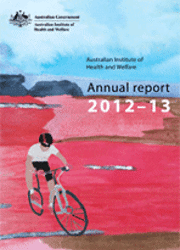Highlights
In 2012–13, the Australian Institute of Health and Welfare (AIHW) continued to focus on activities consistent with its 5 strategic directions.
1 Further strengthen our policy relevance
Key policy relevant deliverables included:
- performance indicator data for Council of Australian Governments’ national agreements
- information provided to new health agencies
- The desire to age in place among older Australians, which drew attention to issues surrounding the divergence between the desire and the ability to age in place, particularly for those with fewer financial resources
- Indigenous primary health care performance indicators as part of National Indigenous Reform Agreement arrangements work with the Australian Bureau of Statistics to source and analyse existing data for the production of the National Mental Health Commission’s inaugural National Report Card on Mental Health and Suicide Prevention.
2 Improve the availability of information for the community and our stakeholders
The AIHW produced 131 products, including 10 web products. Major new reports in 2012–13 included Australia’s food & nutrition 2012, Palliative care services in Australia 2012, Dementia in Australia and Dementia care in hospitals: costs and strategies. There were also regular reports on Australia’s hospitals, homelessness services, housing assistance, children and health expenditure. Online products such as Cardiovascular health were well-received.
Progress was made with access to coded mortality information.
3 Improve information quality, protecting privacy
The AIHW improved its data linkage infrastructure. Its Data Integration Services Centre started operating and is securely managing complex data flows, such as that for the Diabetes Care Project which will evaluate new models of care.
A package of 6 integrated reforms was proposed in the National definitions for elective surgery urgency categories: proposal for the Standing Council on Health in collaboration with the Royal Australasian College of Surgeons.
The quality of child protection data will improve following collaboration with other agencies to implement a new collection.
4 Capitalise on the contemporary information environment
The AIHW improved the timeliness of publishing its Australian hospital statistics reports by using its online data receipt and validation tool, Validata™. As an overall average, the timeliness of release of the AIHW’s annual national data
collections improved.
Use of Validata™ was extended to a number of other collections, including the annual collection from alcohol and other drug treatment services.
5 Cultivate and value a skilled, engaged and versatile workforce
The AIHW further developed its information and communications technology infrastructure, including project management initiatives that will enable staff to improve the quality and timeliness of their work.



